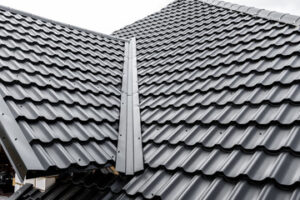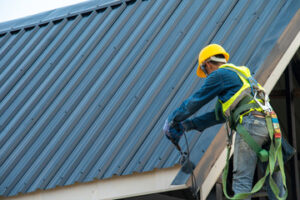Roofing maintenance is key to prolonging the lifespan of any roof. This includes regularly inspecting shingles and gutters to prevent leaks and directing water away from the home, trimming trees to avoid damage from falling branches, and ensuring that attic ventilation is sufficient for healthy shingle roofs.
These regular inspections can save homeowners stress and money down the line by preventing costly repairs from leaking or rot. Visit https://www.fivestarroofingandcontracting.com to learn more.
1. Clean the Gutters

Keeping your gutters clean is one of the most important things you can do for your roof. Gutters help to whisk water and melting snow away from your home, but if they’re clogged, this can cause a lot of problems. For example, water can seep into the fascia and rot it, or it can get under shingles and damage them. Clogged gutters can also lead to water overflow and leakage into your home’s interior.
It’s recommended to clean your gutters at least twice a year. The best times to do this are in the spring and fall, as these seasons bring more mild weather. During these times, it’s easier to spot debris and other issues before they develop.
You can use a ladder to reach the gutters and a scoop or other gutter cleaning tool to remove gunk from the gutters. Be sure to wear gloves and eye protection, as gutter debris can be sharp or contain harmful substances. Alternatively, you can buy a gutter flusher that attaches to a garden hose. This saves you the need for a ladder, but it may not be effective on wet or heavily built-up debris.
While you’re at it, make sure to trim any overhanging branches. This helps to prevent them from tearing or damaging shingles and can discourage algae growth and wood rot. It’s also a good idea to check the flashing for any signs of damage or deterioration. Leaking in the flashing can lead to the deterioration of the roof sheathing, which can lead to more expensive repairs.
If you find that the flashing is damaged or leaking, it’s a good idea to consult with professionals who can perform a thorough inspection and recommend effective solutions. In cases of extensive damage, they can conduct a thorough repair and replacement to ensure long-term protection.
Checking for leaks is something you should do each time you climb on your roof, or at least once a year. This can help you to identify problems before they escalate into significant damage. Generally, it’s a good idea to check for leaks near chimneys, vent pipes, and the corners of your roof. Leaking around these areas is often caused by improper flashing installation, and a professional can fix the problem before it becomes a major issue.
2. Check the Flashing
A roof’s flashing is designed to keep water out of vulnerable areas, like chimneys and skylights. It’s important to check the flashing on a regular basis to ensure it’s doing its job.
Using a ladder, inspect the flashing for cracks and gaps. A gap between the flashing and the wall/roof surface will allow moisture to infiltrate your home, leading to water damage. Check the flashing around chimneys and vent pipes, as well as any areas where the roof meets the walls.
Cracked or displaced flashing can be caused by inclement weather, physical damage, or old age. In some cases, the flashing may be missing altogether, which can lead to a leaky roof.
If you find any cracked or displaced flashing, use roofing cement to seal the area. Also, make sure to clear any debris that has accumulated on or near the flashing. This will help to prevent moisture and mold from forming.
Flashing can be made of a variety of materials, including copper, zinc, or galvanized steel. Copper is often preferred because of its longevity and resistance to corrosion. However, all types of flashing will eventually need to be replaced due to aging and the elements.
If a section of the flashing is missing, or if it’s showing signs of wear and tear, a professional should be called in to replace it. A professional will have the right tools and knowledge to ensure that the new flashing is properly installed, preventing leaks and further damage.
The cost of replacing flashing will vary depending on the type and material used, as well as any sizing miscalculations that result in water penetration and other problems. A quality professional will be able to provide you with a comprehensive estimate before beginning the work, helping you to avoid surprises and unexpected expenses down the road.
The best way to maintain the integrity of your roof is by hiring a professional for a regular inspection and maintenance schedule. At Modernize, we pair you with three to four experienced contractors to help you compare estimates and prices on a roof project.
3. Check the Shingles
When it comes to shingles, the most common type of roof material, it’s important to perform a visual inspection of both the exterior and interior each season. This allows you to identify any issues that may arise from weather damage, moss growth, or other factors. It’s best to walk around the house (if you can safely do so from a ladder) and note any shingles that are missing, broken, or cracked. You can also look in the attic for water stains or discoloration that may indicate a problem with the roof.
A healthy shingle roof will be covered with granules that protect the asphalt layer from UV rays and provide fire resistance. If granules are visible on the ground, your shingles could be starting to wear down. Alternatively, you might see excessive granule accumulation in the gutters or downspouts. It’s important to have any shingle damage assessed as soon as possible, as it can lead to water leaks in the attic or other parts of the home.
Cracked or broken shingles should be replaced as soon as possible, as they leave the roof vulnerable to moisture and molds. It’s also important to have any shingles that are showing signs of curling or warping replaced as well. It’s important to note that these problems can often be caused by hail damage, so it’s always a good idea to have the roof inspected by a professional after a severe storm.
In addition to checking the shingles, you should regularly check the fascia boards for any sign of damage or rot. The fascia boards are the board that run along the edge of your roof and support your gutters. Regular inspections will allow you to quickly catch any issues and have them addressed before they become a bigger problem.
It’s also a good idea to clean your gutters and downspouts periodically to remove any debris that has collected in them. This will help to keep the water flowing properly and minimize any potential clogging or blockages. Finally, you’ll want to make sure that your attic has proper ventilation so that hot air can escape and prevent heat, moisture, or fungus from accumulating inside the roof.
4. Check the Soffit
As Canada is regularly battered by inclement weather, soffits are vulnerable to a variety of damage from the elements. Heavy rains and humidity, coupled with age, can easily wear down fascia boards and roof materials. However, homeowners can often avoid the need for costly repairs by regularly assessing and maintaining their soffits. A soffit is crucial to the overall integrity of a roof and is the first line of defence against leaks, mould, and pests. Cracks, holes, and peeling paint are all signs that your soffit needs prompt attention.
If a soffit is leaking, it’s important to address this as soon as possible to prevent further water damage and mould in your home. If left unattended, the issue can spread to other areas of your roof and cause significant problems, such as rotting wood or damp attic insulation.
Cracks and holes in a soffit are not only unsightly, but they also provide entry points for moisture, pests, and debris. They may also lead to structural issues, such as sagging or warping, which can be difficult and expensive to repair once the problem becomes severe.
Often, these openings are caused by wildlife, which is another reason to keep an eye out for pest activity. Birds, squirrels, rodents, and bees all like to build nests in the gaps between rafters and soffits. They also love to sneak into a house through damaged soffits, where they can cause further damage to roof and attic insulation, or worse, get access to vital electrical wiring.
Blocked soffits and poor attic ventilation can also result in higher energy bills. This is because your HVAC system will have to work harder to regulate the temperature in your attic, which puts unnecessary strain on your soffit. In addition, lack of ventilation can encourage the growth of mold and mildew, causing musty odors and posing health risks to those with asthma or respiratory conditions.
If you’re not comfortable tackling the job yourself, a professional can help you with your soffit maintenance. Regular inspections, safe airflow, and trusted repairs will go a long way to protecting your soffits from serious damage.
